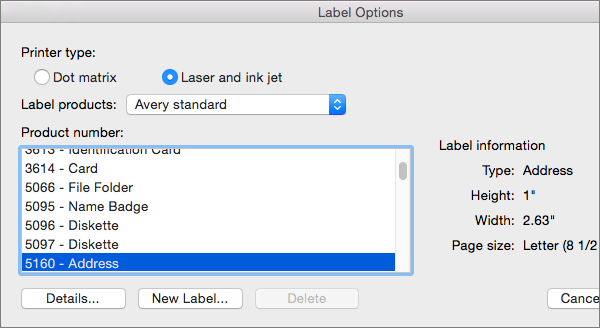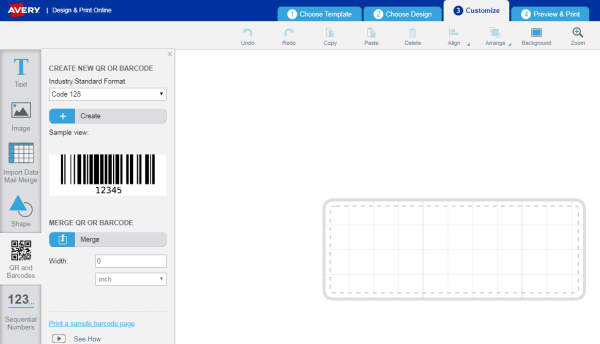Avery Label Template 8195 For Mac
One gripe you’ll hear about, Apple’s otherwise excellent word processing and page layout application, is that it provides little in the way of support for printing labels. But, while it’s true that Pages doesn’t ship with any built-in label templates, it’s actually easy to create and use standard labels using Pages. Step 1: Check to see if there’s a pre-made template Check the Avery site for pre-made label templates designed for use with Apple’s Pages. Sometimes you’ll get lucky. You might already know that you can download tons of Microsoft Word templates for the most common labels directly from the. You can open a Word template in Pages, but you’ll often need to adjust the measurements slightly to make the templates work.
(If you choose to go this route, skip to Step 6.) Avery now offers downloads for a limited selection of templates in a Pages format too. But often you’ll find that there are no downloadable templates available for the label that you want to use. That’s when you need to create a label from scratch. Step 2: Get the measurements Look at your labels to find their measurements. You'll use this information to create your template from scratch.
Labels with no templates typically have measurement information that you can use to create the label manually. For the purposes of this exercise we’re going to use the information that ships with, but you can substitute whatever numbers you need for the labels you want to use. Search the package for measurement information or use a ruler to take measurements from the label itself. You’ll use this information to create the template. Step 3: Create a new document It will be easier to tweak your label layout if you open two Inspector windows, one for document settings and the other for table settings, along with the label document you’re working on. To create your own template, launch Pages (in /Applications) and create a new, blank word processing document. After the blank document appears, open two Inspectors by first choosing Show - Inspector, and then choosing View - New Inspector.
Set one to display document settings and the other to display table settings. When you’re done, your workspace should look like the image above. Step 4: Set up the margins When you’re done making changes to the document layout, your Document Inspector should look like this. Use the document inspector to make changes to the layout of the document using information from the measurements you found. Make sure to remove the checks from the Headers and Footers checkboxes as headers and footers limit the amount of printable space available to you on the page. Step 5: Create a table Set the Header option to zero in the Headers & Footers section of the Table Inspector. Next add a new table to the document using the Table button on the Toolbar.
(Alternatively, you can add a table using the Insert - Table menu.) By default, Pages inserts a three-by-three table with a single header row. You’ll need to change that using the Table Inspector. Select the table and then, in the Inspector, change the body rows and columns to reflect the labels we’re using—20 body rows and 2 body columns.
(We’re getting the information we need for the table from the Number Across and Number Down fields of the 8 Tab label template.) Next, click on each of the buttons under the Header & Footer section and choose zero. Now, change the column width to 1.5 inches and the row height to.5 inch. You should note that the column width field will only allow you to change the number to 1.49 inches. We’ll fix that in a minute. You don’t want each table to automatically resize if you add too much text, so uncheck the the checkbox that says Automatically Resize To Fit Content. Select the Cell Background section and choose None. Step 6: Make necessary tweaks When you’ve made your adjustments, the Table and Document Inspectors should look like this.
You’ll notice that, even though we’ve entered the information exactly as it appears in the measurements on the labels package, our labels don’t all fit on a single page. To fix this you’ll need to adjust the bottom margin, changing it to.4 inch using the Document Inspector (not the Table Inspector). When you’re done, print the template, with the table lines still visible, and hold it up to the light behind one of your labels so that you can compare the lines on your template to the actual lines on the label. For this template, after looking at the label in the light, you’re going to have to make some other minor adjustments.
In this case, I changed the left margin to 2.75 inches; right margin to 2.73 inches; top Margin to.49 inch; and the bottom Margin to.4 inch. Once I made these changes I could change the column width to 1.5 inches. Making adjustments is less a matter of science than it is a matter of judgement.
I suggest that you make smaller changes,.1 inch here.05 inch there, and remember that the Edit - Undo menu is your friend. Step 7: Clean up your template and print When your labels are finished and printed, you'll get something that looks like this. Once you’re satisfied with your template, use the Table Inspector to remove the cell borders from your table. First, select the table. (One way to do this is to control-click on the table and choose Select All.) Then select None from the Table Inspector’s cell borders menu. When you’re satisfied with your work, save your new label as a Pages template so you can use it again in the future (File - Save as Template). Now you're ready to print out your labels.
Jeffery Battersby is an Apple Certified Trainer, (very) smalltime actor, and regular contributor to Macworld. He writes about Macs and more at his.

Avery Label Template 8195 For Mac Software
. In the Contacts app on your Mac, or a group. Only contact cards with addresses will be printed. If you want to print a return address label, select. Choose File Print. Click the Style pop-up menu, then choose Mailing Labels.
If you don’t see the Style pop-up menu, click Show Details near the bottom left corner. Click Layout or Label to set options. Layout: Choose a label type, such as Avery Standard or A4.
Or choose Define Custom to create and define your own label. Label: Choose additional items to include on labels.
Avery 8195 Template Download

For example, you can:. Print labels in alphabetical order or by postal code. Include company or country names. Include an image. Change the font and font color.
Click Print. To change the order of the first and last name in mailing labels, change the setting of the Show First Name option in. In the Contacts app on your Mac, or a group. Only contact cards with addresses will be printed.
Choose File Print. Click the Style pop-up menu, then choose Envelopes. If you don’t see the Style pop-up menu, click Show Details near the bottom left corner. Click Layout, Label, or Orientation to set options. Layout: Choose a standard envelope size from International, North American, or Japanese layouts.
Or for a nonstandard envelope size, choose Define Custom to create and define your own layout. Label: Choose additional items to include on envelopes. For example, you can:. Include your return address (it must appear on ). Print an envelope for a specific address (such as work) or all addresses (for contacts who have multiple addresses). Print envelopes in alphabetical order or by postal code. Include company or country names.
Include an image. Change the font and font color Orientation: Print envelopes in portrait or landscape orientation.
Avery 8195 Template For Word

Click Print.